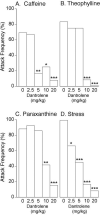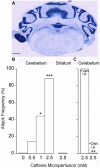Stress, caffeine and ethanol trigger transient neurological dysfunction through shared mechanisms in a mouse calcium channelopathy
- PMID: 23009754
- PMCID: PMC3534906
- DOI: 10.1016/j.nbd.2012.09.005
Stress, caffeine and ethanol trigger transient neurological dysfunction through shared mechanisms in a mouse calcium channelopathy
Abstract
Several episodic neurological disorders are caused by ion channel gene mutations. In patients, transient neurological dysfunction is often evoked by stress, caffeine and ethanol, but the mechanisms underlying these triggers are unclear because each has diverse and diffuse effects on the CNS. Attacks of motor dysfunction in the Ca(V)2.1 calcium channel mouse mutant tottering are also triggered by stress, caffeine and ethanol. Therefore, we used the tottering mouse attacks to explore the pathomechanisms of the triggers. Despite the diffuse physiological effects of these triggers, ryanodine receptor blockers prevented attacks induced by all of them. In contrast, compounds that potentiate ryanodine receptors triggered attacks suggesting a convergent biochemical pathway. Tottering mouse attacks were both induced and blocked within the cerebellum suggesting that the triggers act locally to instigate attacks. In fact, stress, caffeine and alcohol precipitated attacks in Ca(V)2.1 mutant mice in which genetic pathology was limited to cerebellar Purkinje cells, suggesting that the triggers initiate dysfunction within a specific brain region. The surprising biochemical and anatomical specificity of the triggers and the discovery that the triggers operate through shared mechanisms suggest that it is possible to develop targeted therapies aimed at blocking the induction of episodic neurological dysfunction, rather than treating the symptoms once provoked.
Copyright © 2012 Elsevier Inc. All rights reserved.
Figures






Similar articles
-
Triggers of paroxysmal dyskinesia in the calcium channel mouse mutant tottering.Pharmacol Biochem Behav. 2002 Oct;73(3):631-7. doi: 10.1016/s0091-3057(02)00854-7. Pharmacol Biochem Behav. 2002. PMID: 12151038
-
Potassium channel blockers inhibit the triggers of attacks in the calcium channel mouse mutant tottering.J Neurosci. 2005 Apr 20;25(16):4141-5. doi: 10.1523/JNEUROSCI.0098-05.2005. J Neurosci. 2005. PMID: 15843617 Free PMC article.
-
Aberrant cerebellar Purkinje cell activity as the cause of motor attacks in a mouse model of episodic ataxia type 2.Dis Model Mech. 2018 Sep 21;11(9):dmm034181. doi: 10.1242/dmm.034181. Dis Model Mech. 2018. PMID: 30279196 Free PMC article.
-
Zebrin II expressing Purkinje cell phenotype-related and -unrelated cerebellar abnormalities in Cav2.1 mutant, rolling mouse Nagoya.ScientificWorldJournal. 2010 Oct 12;10:2032-8. doi: 10.1100/tsw.2010.205. ScientificWorldJournal. 2010. PMID: 20953553 Free PMC article. Review.
-
Ion channel mutations in mouse models of inherited neurological disease.Ann Med. 1997 Dec;29(6):569-74. doi: 10.3109/07853899709007484. Ann Med. 1997. PMID: 9562526 Review.
Cited by
-
Abnormal excitability and episodic low-frequency oscillations in the cerebral cortex of the tottering mouse.J Neurosci. 2015 Apr 8;35(14):5664-79. doi: 10.1523/JNEUROSCI.3107-14.2015. J Neurosci. 2015. PMID: 25855180 Free PMC article.
-
The Anatomical Basis for Dystonia: The Motor Network Model.Tremor Other Hyperkinet Mov (N Y). 2017 Oct 23;7:506. doi: 10.7916/D8V69X3S. eCollection 2017. Tremor Other Hyperkinet Mov (N Y). 2017. PMID: 29123945 Free PMC article. Review.
-
The PRRT2 knockout mouse recapitulates the neurological diseases associated with PRRT2 mutations.Neurobiol Dis. 2017 Mar;99:66-83. doi: 10.1016/j.nbd.2016.12.018. Epub 2016 Dec 20. Neurobiol Dis. 2017. PMID: 28007585 Free PMC article.
-
Mutational consequences of aberrant ion channels in neurological disorders.J Membr Biol. 2014 Nov;247(11):1083-127. doi: 10.1007/s00232-014-9716-2. Epub 2014 Aug 14. J Membr Biol. 2014. PMID: 25119057 Review.
-
Mechanism of stress-induced attacks in an episodic neurologic disorder.Sci Adv. 2022 Apr 22;8(16):eabh2675. doi: 10.1126/sciadv.abh2675. Epub 2022 Apr 20. Sci Adv. 2022. PMID: 35442745 Free PMC article.
References
-
- Bhatia KP. Familial (idiopathic) paroxysmal dyskinesias: an update. Semin Neurol. 2001;21:69–74. - PubMed
-
- Bhatia KP, Griggs RC, Ptacek LJ. Episodic movement disorders as channelopathies. Mov Disord. 2000;15:429–33. - PubMed
-
- Campbell DB, Hess EJ. Cerebellar circuitry is activated during convulsive episodes in the tottering (tg/tg) mutant mouse. Neuroscience. 1998;85:773–83. - PubMed
-
- Cannon SC. Pathomechanisms in channelopathies of skeletal muscle and brain. Annu Rev Neurosci. 2006;29:387–415. - PubMed
Publication types
MeSH terms
Substances
Grants and funding
LinkOut - more resources
Full Text Sources
Other Literature Sources
Medical

